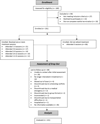The impact of familial involvement on dropout in a culturally informed group therapy for people diagnosed with 'schizophrenia'
- PMID: 38617133
- PMCID: PMC11008700
- DOI: 10.1080/17522439.2022.2118358
The impact of familial involvement on dropout in a culturally informed group therapy for people diagnosed with 'schizophrenia'
Abstract
Background: Individuals with schizophrenia diagnoses are high-risk for dropout from mental health treatments, yet few studies have examined whether familial involvement in therapy impacts dropout.
Methods: We examined whether familial involvement and other demographic variables predicted dropout among 101 patients enrolled in culturally informed group therapy for schizophrenia (CIGT-S), which incorporates collectivistic principles and spiritual coping into treatment. We reviewed records and conducted follow-up calls to identify reasons for dropout, and performed survival analyses to identify when dropout was likely.
Results: Familial involvement was linked to greater engagement with treatment and lower dropout, signifying a mechanism for improving treatment attendance in this group. Ethnic minorities and patients with higher symptom severity demonstrated higher rates of dropout. Most patients dropped out of CIGT-S before treatment began. However, significantly lower levels of dropout were observed among those who made it to session 9 (end of the spirituality module). An inability to maintain contact with participants was the most cited reason for dropout within records, and structural reasons (e.g., moving away) were commonly cited among participants who were successfully followed-up with.
Discussion: Future work may identify whether family functioning or the quality of familial relationships may predict familial involvement and, consequently, treatment attendance.
Keywords: culture; family; schizoaffective disorder.
Conflict of interest statement
Disclosure of interest: The authors report there are no competing interests to declare.
Figures
References
-
- Cohen CI (1993). Poverty and the course of schizophrenia: Implications for research and policy. Psychiatric Services, 44(10), 951–958. - PubMed
-
- Cotter RB, Burke JD, Stouthamer-Loeber M, & Loeber R (2005). Contacting participants for follow-up: how much effort is required to retain participants in longitudinal studies?. Evaluation and Program Planning, 28(1), 15–21.
-
- Crawford MJ, de Jonge E, Freeman GK, & Weaver T (2004). Providing continuity of care for people with severe mental illness. Social Psychiatry and Psychiatric Epidemiology, 39(4), 265–272. - PubMed
-
- de Haan L, Linszen DH, Lenior ME, Doderlein de Win E, & Gorsira R (2003). Duration of untreated psychosis and outcome of schizophrenia: Delay in intensive psychosocial treatment versus delay in treatment with antipsychotic medication. Schizophrenia Bulletin, 29(2), 341–348. doi:10.1093/oxfordjournals.schbul.a007009 - DOI - PubMed
Grants and funding
LinkOut - more resources
Full Text Sources



